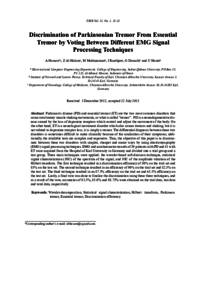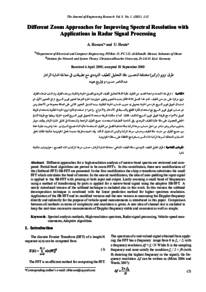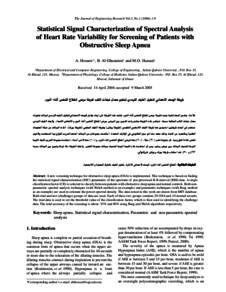وثيقة
Discrimination of parkinsonian tremor from essential tremor by voting between different EMG signal processing techniques.
المساهمون
الناشر
Sultan Qaboos University
ميلادي
2014
اللغة
الأنجليزية
الموضوع
الملخص الإنجليزي
Parkinson's disease (PD) and essential tremor (ET) are the two most common disorders that cause involuntary muscle shaking movements, or what is called "tremor". PD is a neurodegenerative disease caused by the loss of dopamine receptors which control and adjust the movement of the body. On the other hand, ET is a neurological movement disorder which also causes tremors and shaking, but it is not related to dopamine receptor loss; it is simply a tremor. The differential diagnosis between these two disorders is sometimes difficult to make clinically because of the similarities of their symptoms; additionally, the available tests are complex and expensive. Thus, the objective of this paper is to discriminate between these two disorders with simpler, cheaper and easier ways by using electromyography (EMG) signal processing techniques. EMG and accelerometer records of 39 patients with PD and 41 with ET were acquired from the Hospital of Kiel University in Germany and divided into a trial group and a test group. Three main techniques were applied: the wavelet-based soft-decision technique, statistical signal characterization (SSC) of the spectrum of the signal, and SSC of the amplitude variation of the Hilbert transform. The first technique resulted in a discrimination efficiency of 80% on the trial set and 85%on the test set. The second technique resulted in an efficiency of 90% on the trial set and 82.5% on the test set. The third technique resulted in an 87.5% efficiency on the trial set and 65.5% efficiency on the test set. Lastly, a final vote was done to finalize the discrimination using these three techniques, and as a result of the vote, accuracies of 92.5%, 85.0% and 88.75% were obtained on the trial data, test data and total data, respectively.
المجموعة
ISSN
1726-6742
URL المصدر
zcustom_txt_2
Hossen, A., AlHakim, Z., Muthuraman, M., Raethjen, J., Deuschl, G., & Heute, U. (2014). Discrimination of parkinsonian tremor from essential tremor by voting between different EMG signal processing techniques. The Journal of Engineering Research, 11 (1),
الملخص العربي
من أكثر الاضطرابات العصبية شهرة : مرض الباركنسون والارتعاش الاضطراري، وكلا المرضين يسببان الاهتزاز والحركات اللاإرادية للعضلات. الباركنسون هو مرض عصبي يكون بسبب نقص أو فقدان ما يسمى بمستقبلات : " الدوبامين ". الذي يعمل كمراسل بين المخ والعضلات لتنظيم حركة الجسم وفي حالة الباركنسون يتم فقدان السيطرة على حركة الجسم. أما الارتعاش الاضطراري فهو عبارة عن اضطراب أكثر منه مرضا، فهو يسبب الارتعاش ولكن ليس له علاقة نهائيا بالدوبامين، فهو على قول الأطباء : " إنه ببساطة ارتعاش فقط ". في كثير من الأحيان يختلط التشخيص بين المرضين على الطبيب خاصة أن الطبيب يعتمد بشكل كبير على الأعراض الناتجة والتي هي جدا متشابهة بين هذين المرضين. هذا بالإضافة إلى أن وسائل الفحص المستخدمة في هذا الوقت معقدة ومكلفة فاللجوء إلى طرق أسهل وأرخص أمر مرغوب. ولهذا فإن هذه الدراسة تطمح إلى تطبيق طرق سهلة، رخيصة لتزيد من كفاءة التشخيص. هذه الدراسة تعتمد على استخدام معالجة الإشارات العضلية من الجسم، حيث جمعت بيانات هذه الإشارات من 39 مريضا بالباركنسون و 41 مريضا بالارتعاش الاضطراري. هذه البيانات مقسمة إلى قسمين : 40 لإجراء التجارب، والقسم الآخر لإجراء الاختبارات. وكل هذه البيانات أخذت من مستشفى جامعة كيل في ألمانيا. طبقت ثلاث طرق مختلفة في هذه الدراسة لتشخيص مرضى الباركنسون من مرضى الارتعاش الاضطراري وهي : التقنية الأولى : تقنية تحويل المويجات والتي أعطت دقة تشخيص 80% على بيانات التجارب و85% على بيانات الاختبار. التقنية الثانية : تقنية الوصف الإحصائي لتحويل فورير السريع و التي أعطت دقة تشخيص 90% على بيانات التجارب و82.5% على بيانات الاختبار. التقنية الثالثة : تقنية الوصف الإحصائي لمتغير المقدار لتحويل هيربرت والتي أعطت دقة تشخيص 87.5% على بيانات التجارب و65.5% على بيانات الاختبار. ثم بعد ذلك تطبيق نظام "التصويت" لعمل خلاصة لهذه النتائج من الطرق الثلاثة والنتيجة الأخيرة هي دقة تشخيص 92.5% على بيانات التجارب و85% على بيانات الاختبار و88.75% على البيانات الكلية.
قالب العنصر
مقالات الدوريات



